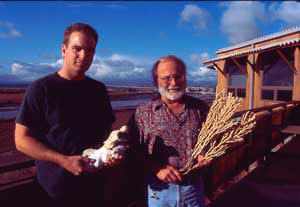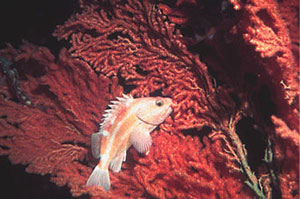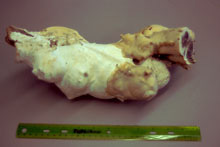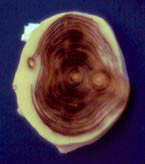 by Doug Schneider March 11, 2005
A thousand feet below the surface of the North Pacific Ocean, off Alaska, live colonies of red tree coral. Some of these corals grow to as much as ten feet high, with branches that spread out like a giant fan. The tips of the coral are thin, delicate. In a way, the coral looks a bit like parsley. Around the bases of these coral, rockfish dart here and there, perhaps looking for a place to hide or an easy meal. Gregor Cailliet is a marine scientist at Moss Landing Marine Laboratories in California. He says Alaska's deep-sea corals, like coral everywhere, provide essential habitat for fish. Cailliet said, "These corals add habitat in that they're like trees. So there's a lot of structure on the sea floor that wouldn't be there normally that provide habitat for other organisms as well, some of which deep water fish feed on. You get invertebrates occupying niches in these corals that are also occupied by fishes." Many people think of coral as plants, but that's not really true. Allen Andrews is a research associate at Moss Landing. He says that while they might look like plants, they're actually animals. Andrews said, "It's actually a whole collection of organisms living together where they share food collected from the water column. They're filter-feeding organisms. These corals are not photosynthetic. They rely on collecting food from the water column." Scientists have always thought
corals lived a long time, but they weren't really sure just how
long the corals in Alaska's deep, cold waters live. Recently,
Andrews and Cailliet conducted studies to determine the age of
Alaska's tree corals. Their work is being done with funding from
the North Pacific Marine Research Program at the University of
Alaska Fairbanks. Allen Andrews. Radiochemistry is a complicated science but essentially it involves the measure of naturally occurring radioactive elements in an object or an organism. By calculating the amount of a decayed radioactive element, scientists can determine its age. Using these techniques, Andrews found that red tree coral in the Gulf of Alaska grew slowly but lived a long time.
Andrews said, "The growth rate we got was 1.74 cm per year from this one arm of the colony. Something that's two meters or so tall is probably 150 to 200 years old." Andrews says figuring out how old things are offers him the chance to dispel people's ideas about longevity. Andrews said, "It's fascinating to me to determine how old things are. In addition, I enjoy sharing that information with people because it tends to be shocking. I really enjoy telling them that they get to be 100, 120 and some cases maybe 200 years old. It's fun being on the frontier of this kind of science." Gregor Cailliet is concerned about Alaska's corals because such they tend to mature later and reproduce slowly. He says any major disturbance, such as bottom fishing, could wreak havoc on coral communities and the fish species they support. Cailliet said, "The trawling industry, in some cases, if they just go through these habitats, can rip out hundreds if not more of these things. If they live a long time, it will take a long time for them to recover. Recruitment to those habitats is a very slow rate. Growing up to be the size of some of these corals takes hundreds of years."
This story is courtesy of Arctic Science Journeys Radio.
Arctic Science Journeys is a radio service highlighting science,
culture, and the environment of the circumpolar north. Produced
by the Alaska Sea Grant College Program and the University of
Alaska Fairbanks.
|
||||||



